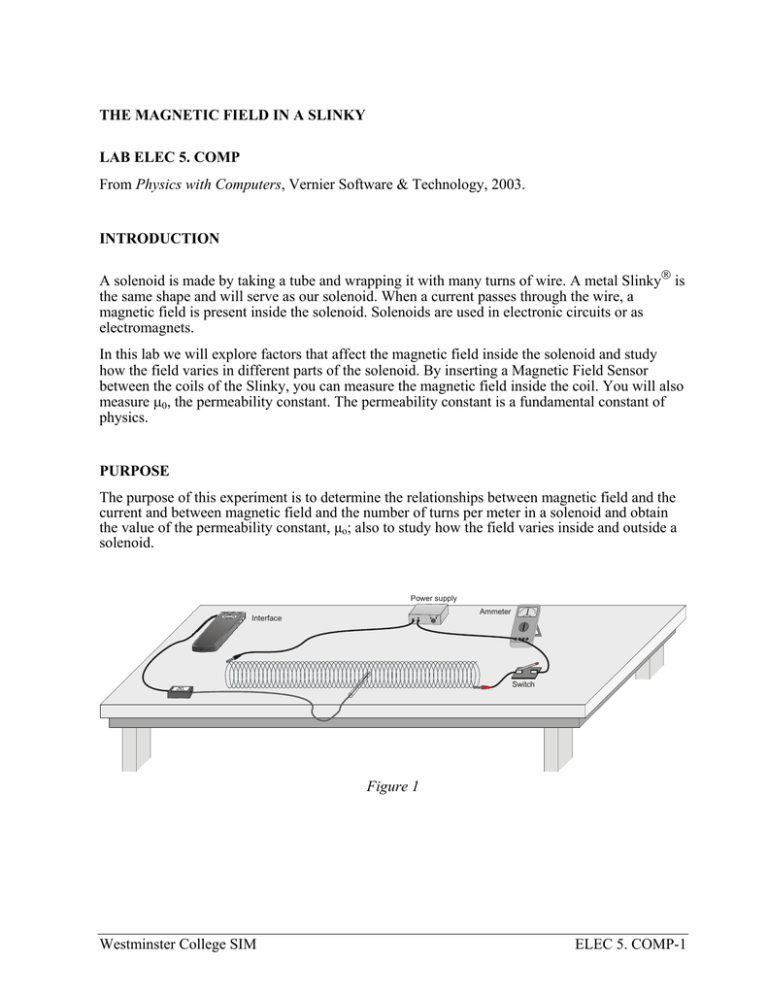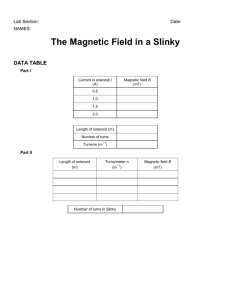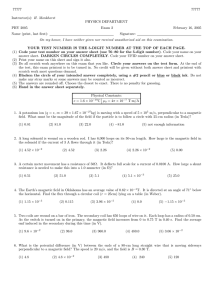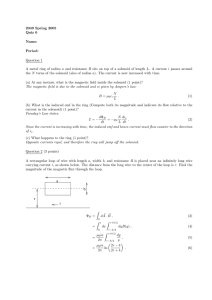Document 12916700
advertisement

THE MAGNETIC FIELD IN A SLINKY LAB ELEC 5. COMP From Physics with Computers, Vernier Software & Technology, 2003. INTRODUCTION A solenoid is made by taking a tube and wrapping it with many turns of wire. A metal Slinky® is the same shape and will serve as our solenoid. When a current passes through the wire, a magnetic field is present inside the solenoid. Solenoids are used in electronic circuits or as electromagnets. In this lab we will explore factors that affect the magnetic field inside the solenoid and study how the field varies in different parts of the solenoid. By inserting a Magnetic Field Sensor between the coils of the Slinky, you can measure the magnetic field inside the coil. You will also measure µ0, the permeability constant. The permeability constant is a fundamental constant of physics. PURPOSE The purpose of this experiment is to determine the relationships between magnetic field and the current and between magnetic field and the number of turns per meter in a solenoid and obtain the value of the permeability constant, µo; also to study how the field varies inside and outside a solenoid. Power supply Interface V Ammeter mV Switch Figure 1 Westminster College SIM ELEC 5. COMP-1 The Magnetic Field in a Slinky MATERIALS Computer Vernier computer interface Logger Pro Vernier Magnetic Field Sensor Slinky Switch Meter stick DC power supply Ammeter Cardboard spacers Connecting wires Tape and cardboard Ring stand Angle clamp INITIAL SETUP 1. Connect the Vernier Magnetic Field Sensor to Channel 1 of the interface. Set the switch on the sensor to High. 2. Stretch the Slinky until it is about 1 m long. The distance between the coils should be about 1 cm. Use the non-conducting special mounts to hold the Slinky at this length. 3. Set up the circuit and equipment as shown in Figure 1. Wires with clips on the end should be used to connect to the Slinky. If your power supply has an accurate internal ammeter you do not need an additional external ammeter. 4. Turn on the power supply and adjust it so that the ammeter reads 2.0 A when the switch is held closed. Note: This lab requires fairly large currents to flow through the wires and Slinky. Only close the switch so the current flows when you are taking a measurement. The Slinky, wires, and possibly the power supply may get hot if left on continuously. 5. Open the file “29 Magnetic Field in Slinky” in the Physics with Computers folder. A graph will appear on the screen. The display of the magnetic field is in millitesla, mT. The meter is a live display of the magnetic field intensity. PRELIMINARY QUESTIONS 1. Hold the switch closed. The current should be 2.0 A. Place the Magnetic Field Sensor between the turns of the Slinky near its center. Rotate the sensor and determine which direction gives the largest magnetic field reading. What direction is the white dot on the sensor pointing? 2. What happens if you rotate the white dot to point the opposite way? What happens if you rotate the white dot so it points perpendicular to the axis of the solenoid? 3. Stick the Magnetic Field Sensor through different locations along the Slinky to explore how the field varies along the length. Always orient the sensor to read the maximum magnetic field at that point along the Slinky. How does the magnetic field inside the solenoid seem to vary along its length? 4. Check the magnetic field intensity just outside the solenoid. Westminster College SIM ELEC 5. COMP-2 The Magnetic Field in a Slinky PROCEDURE Part I How Is The Magnetic Field In A Solenoid Related To The Current? For the first part of the experiment you will determine the relationship between the magnetic field at the center of a solenoid and the current flowing through the solenoid. As before, leave the current off except when making a measurement. 1. Place the Magnetic Field Sensor between the turns of the Slinky near its center. 2. Close the switch and rotate the sensor so that the white dot points directly down the long axis of the solenoid. This will be the position for all of the magnetic field measurements for the rest of this lab. Figure 2 3. Click current. to begin data collection. Wait a few seconds and close the switch to turn on the 4. If the magnetic field increases when the switch is closed, you are ready to take data. If the field decreases when you close the switch, rotate the Magnetic Field Sensor so that it points the other direction down the solenoid. 5. With the Magnetic Field Sensor in position and the switch open, click the Zero button, , to zero the sensor and remove readings due to the Earth’s magnetic field, any magnetism in the metal of the Slinky, or the table. 6. Adjust the power supply so that 0.5 A will flow through the coil when the switch is closed. 7. Click collection. to begin data collection. Close the switch for at least 10 seconds during the data 8. View the field vs. time graph and determine the region of the curve where the current was flowing in the wire. Select this region on the graph by dragging over it. Determine the average field strength while the current was on by clicking the Statistics button, . Record the average field in the data table. 9. Increase the current by 0.5 A and repeat Steps 7 and 8. 10. Repeat Step 9 up to a maximum of 2.0 A. 11. Count the number of turns of the Slinky and measure its length. If you have any unstretched part of the Slinky at the ends, do not count it for either the turns or the length. Calculate the number of turns per meter of the stretched portion. Record the length, turns, and the number of turns per meter in the data table. Westminster College SIM ELEC 5. COMP-3 The Magnetic Field in a Slinky Part II How is the Magnetic Field in a Solenoid Related to the Spacing of the Turns? For the second part of the experiment, you will determine the relationship between the magnetic field in the center of a coil and the number of turns of wire per meter of the solenoid. You will keep the current constant. Leave the Slinky set up as shown in Figure 1 (slinky about 1.00m in length). The sensor will be oriented as it was before, so that it measures the field down the middle of the solenoid. You will be changing the length of the Slinky from 0.5 to 2.0 m to change the number of turns per meter. 12. Adjust the power supply so that the current will be 1.5 A when the switch is closed. 13. With the Magnetic Field Sensor in position, but no current flowing, click to zero the sensor and remove readings due to the Earth’s magnetic field and any magnetism in the metal of the Slinky. Since the Slinky is made of an iron alloy, it can be magnetized itself. Moving the Slinky around can cause a change in the field, even if no current is flowing. This means you will need to zero the reading each time you move or adjust the Slinky. 14. Click to begin data collection. Close and hold the switch for about 10 seconds during the data collection. As before, leave the switch closed only during actual data collection. 15. View the field vs. time graph and determine where the current was flowing in the wire. Select this region on the graph by dragging over it. Find the average field while the current was on by clicking on the Statistics button, . Count the number of turns of the Slinky and measure its length. If you have any unstretched part of the Slinky at the ends, do not count it for either the turns or the length. Record the length of the Slinky and the average field in the data table. 16. Repeat Steps 13 – 15 after changing the length of the Slinky to 0.5 m, 1.5 m, and 2.0 m. Each time, zero the Magnetic Field Sensor with the current off. Make sure that the current remains at 1.5 A each time you turn it on. Westminster College SIM ELEC 5. COMP-4 The Magnetic Field in a Slinky DATA TABLE Part I Current in solenoid I (A) Magnetic field B (mT) 0.5 1.0 1.5 2.0 Length of solenoid (m) Number of turns Turns/m (m–1) Part II Length of solenoid (m) Turns/meter n (m–1) Magnetic field B (mT) Number of turns in Slinky Westminster College SIM ELEC 5. COMP-5 The Magnetic Field in a Slinky ANALYSIS 1. On Page 2 of the experiment file, plot a graph of magnetic field B vs. the current I through the solenoid. 2. How is magnetic field related to the current through the solenoid? 3. Determine the equation of the best-fit line, including the y-intercept. Note the constants and their units. 4. For each of the measurements of Part II, calculate the number of turns per meter. Enter these values in the Data Table. 5. On Page 3 of the experiment file, plot a graph of magnetic field B vs. the turns per meter of the solenoid (n). 6. How is magnetic field related to the turns/meter of the solenoid? 7. Determine the equation of the best-fit line to your graph. Note the constants and their units. 8. From Ampere’s law, it can be shown that the magnetic field B inside a long solenoid is B = µ 0 nI where µ0 is the permeability constant. Do your results agree with this equation? Explain. 9. Assuming the equation in the previous question applies for your solenoid, calculate the value of µ0 using your graph of B vs. n. 10. Look up the value of µ0, the permeability constant. Compare it to your experimental value. 11. Was your Slinky positioned along an east-west, north-south, or on some other axis? Will this have any effect on your readings? EXTENSIONS 1. Carefully measure the magnetic field at the end of the solenoid. How does it compare to the value at the center of the solenoid? Try to prove what the value at the end should be. 2. Study the magnetic field strength inside and around a toroid, a circular-shaped solenoid. 3. If you have studied calculus, refer to a calculus-based physics text to see how the equation for the field of a solenoid can be derived from Ampere’s law. 4. If you look up the permeability constant in a reference, you may find it listed in units of henry/meter. Show that these units are the same as tesla-meter/ampere. 5. Take data on the magnetic field intensity vs. position along the length of the solenoid. Check the field intensity at several distances along the axis of the Slinky past the end. Note any patterns you see. Plot a graph of magnetic field (B) vs. distance from center. How does the value at the end of the solenoid compare to that at the center? How does the value change as you move away from the end of the solenoid 6. Insert a steel or iron rod inside the solenoid and see what effect that has on the field intensity. Be careful that the rod does not short out with the coils of the Slinky. You may need to change the range of the Magnetic Field Sensor. 7. Use the graph obtained in Part I to determine the value of µ0. Westminster College SIM ELEC 5. COMP-6






